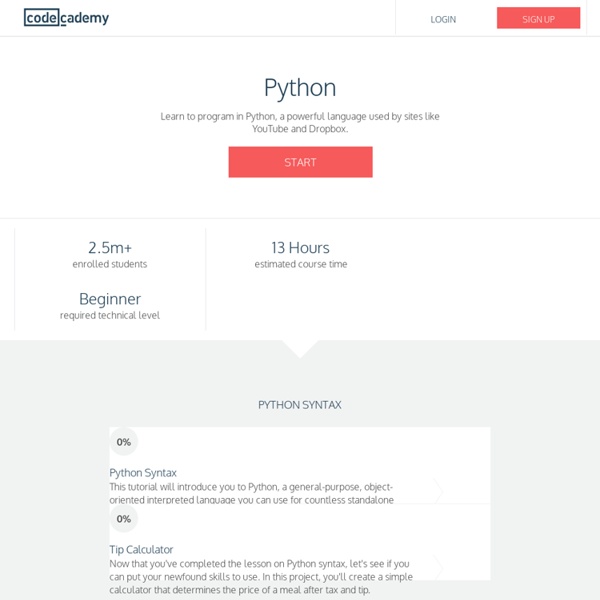



http://www.codecademy.com/en/tracks/python
Python Ecosystem - An Introduction » mirnazim.org When developers shift from PHP, Ruby or any other platform to Python, the very first road block they face (most often) is a lack of an overall understanding of the Python ecosystem. Developers often yearn for a tutorial or resource that explains how to accomplish most tasks in a more or less standard way. What follows is an extract from the internal wiki at my workplace, which documents the basics of the Python ecosystem for web application development for our interns, trainees and experienced developers who shift to Python from other platforms. Getting Started with Python on Heroku flask python Table of Contents This quickstart will get you going with a Python application that uses the Flask web framework, deployed to Heroku. For Django apps, please see the Getting Started with Django on Heroku. For general information on how to develop and architect apps for use on Heroku, see Architecting Applications for Heroku.
BeginnersGuide - PythonInfo Wiki New to programming? Python is free and easy to learn if you know where to start! This guide will help you to get started quickly. Chinese Translation New to Python? The Python Tutorial — Python v2.7.5 documentation Python is an easy to learn, powerful programming language. It has efficient high-level data structures and a simple but effective approach to object-oriented programming. Python’s elegant syntax and dynamic typing, together with its interpreted nature, make it an ideal language for scripting and rapid application development in many areas on most platforms. The Python interpreter and the extensive standard library are freely available in source or binary form for all major platforms from the Python Web site, and may be freely distributed.
s Python Class - Educational Materials Welcome to Google's Python Class -- this is a free class for people with a little bit of programming experience who want to learn Python. The class includes written materials, lecture videos, and lots of code exercises to practice Python coding. These materials are used within Google to introduce Python to people who have just a little programming experience. The first exercises work on basic Python concepts like strings and lists, building up to the later exercises which are full programs dealing with text files, processes, and http connections. The class is geared for people who have a little bit of programming experience in some language, enough to know what a "variable" or "if statement" is. Beyond that, you do not need to be an expert programmer to use this material.
7 Major Players In Free Online Education By Jennifer Berry Imagine a world where free, college-level education was available to almost everyone. Believe it or not, you're living in that world right now. Online education has been around for decades, but in the past couple of years, interest has spiked for massive open online courses, otherwise known as MOOCs, according to Brian Whitmer, co-founder of Instructure, an education technology company that created the Canvas Network, a platform for open online courses.
50 Places You Can Learn to Code (for Free) Online If you’re curious about learning a programming language then you’re in luck: there’s no shortage of resources for learning how to code online. University-level courses, tutorials, cheat sheets, and coding communities all offer excellent ways to pick up a new language, and maybe even a new job, too. Read on, and you’ll discover 50 great places to learn how to code, for free, online. Become a Programmer, Motherfucker If you don't know how to code, then you can learn even if you think you can't. Thousands of people have learned programming from these fine books: Learn Python The Hard Way Learn Ruby The Hard Way Learn Code The Hard Way
13 Sites to Download Free eBooks eBooks have become very popular with devices such as the Kindle and the new iPad. You can get applications for your smart phone to read PDF files and eBooks from most popular book sites. There ia a large choice of eBooks and many are free. Amazon has a collection of free eBooks for their Kindle reader so be sure and check their site. 100+ Ways to Learn Anything on the Internet Learn Anything... Thanks to this amazing collection of educational websites you can become a master in anything from home renovations to rocket science, maths to photography, art to computer programming. What are you going to master today?
100 Websites You Should Know and Use (updated!) Entertainment Meet David Peterson, who developed Dothraki for Game of Thrones There are seven different words in Dothraki for striking another person with a sword. Google Releases Open-Source Online-Education Software - Wired Campus Google has taken what its officials call an “experimental first step” into online education, releasing open-source software called Course Builder in hopes that universities will use it to deliver free online courses. The search giant says it is in talks with edX—a partnership among Harvard University, the Massachusetts Institute of Technology, and the University of California at Berkeley to offer free online courses—though officials declined to comment further. A post on Google’s research blog this week also cited nine universities interested in using the platform, including Stanford University. “We’ve been in touch with a number of universities, and I think it’s a confusing time or an exciting time,” said Peter Norvig, Google’s director of research, in an interview with The Chronicle late Wednesday.